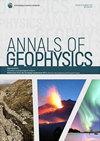Understanding the structure of crust and shallow upper mantle beneath western Tibet through the joint inversion of Rayleigh wave group velocity dispersion with interpolated receiver functions
IF 1.2
4区 地球科学
Q3 GEOCHEMISTRY & GEOPHYSICS
引用次数: 0
Abstract
We present the 3-D shear wave velocity variationin the crust and upper mantle structure of western Tibet using a joint inversion of Rayleigh wave group velocity dispersion and interpolated receiver function. The lateral sampling of the receiver function and the surface wave dispersion is equalized by the interpolation scheme. This new method of spatial interpolation eliminates difficulties caused by back azimuthal variation in the receiver function. We have jointly inverted these interpolated receiver functions with the Rayleigh wave group velocity dispersions obtained from the earthquake and ambient noise tomography to map the tectonic structure of western Tibet. The study reveals remarkable variation of the seismic characteristics in the crust and shallow upper mantle of western Tibet. The mapped Moho depth is ~74 km in the northern part of the plateau, whereas it is ~69 km in the southern part. A thick mid-crustal slow-velocity zone from ~10km up to ~40 km depth has been observed, which could be attributed to partial melt. A noteworthy finding is the variation in slower crustal velocity between the south and north of the Lhasa Block (LB). We interpret this as the Indian crust that has been underthrusted beneath the Tibetan plateau, and the northern limit of the Indian lithosphere extends to the southern part of the LB.通过内插接收函数联合反演瑞利波群速度频散了解西藏西部地壳和浅上地幔结构
我们利用瑞利波群速度频散和插值接收函数联合反演,展示了西藏西部地壳和上地幔结构中的三维剪切波速度变化。接收函数和面波频散的横向采样通过插值方案得到均衡。这种新的空间插值方法消除了接收机函数方位角反向变化所造成的困难。我们将这些插值接收函数与地震和环境噪声层析成像获得的瑞利波群速度频散联合反演,绘制了西藏西部的构造结构图。该研究揭示了西藏西部地壳和浅上地幔的地震特征的显著变化。绘制的莫霍深度在高原北部约为 74 千米,而在南部约为 69 千米。从~10千米到~40千米的地壳中层慢速带很厚,可能是部分熔融造成的。一个值得注意的发现是拉萨地块(LB)南部和北部之间地壳慢速的变化。我们将此解释为印度地壳在青藏高原下发生了下推,印度岩石圈的北部界限延伸到了拉萨地块的南部。
本文章由计算机程序翻译,如有差异,请以英文原文为准。
求助全文
约1分钟内获得全文
求助全文
来源期刊

Annals of Geophysics
地学-地球化学与地球物理
CiteScore
2.40
自引率
0.00%
发文量
38
审稿时长
4-8 weeks
期刊介绍:
Annals of Geophysics is an international, peer-reviewed, open-access, online journal. Annals of Geophysics welcomes contributions on primary research on Seismology, Geodesy, Volcanology, Physics and Chemistry of the Earth, Oceanography and Climatology, Geomagnetism and Paleomagnetism, Geodynamics and Tectonophysics, Physics and Chemistry of the Atmosphere.
It provides:
-Open-access, freely accessible online (authors retain copyright)
-Fast publication times
-Peer review by expert, practicing researchers
-Free of charge publication
-Post-publication tools to indicate quality and impact
-Worldwide media coverage.
Annals of Geophysics is published by Istituto Nazionale di Geofisica e Vulcanologia (INGV), nonprofit public research institution.
 求助内容:
求助内容: 应助结果提醒方式:
应助结果提醒方式:


